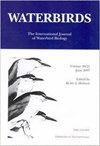Factors Affecting Colony Size and Breeding Parameters of Eared Grebe (Podiceps nigricollis) in Carp Ponds
IF 0.6
4区 生物学
Q3 ORNITHOLOGY
引用次数: 1
Abstract
Abstract. Understanding important factors for breeding Eared Grebes (Podiceps nigricollis) is essential for its conservation. We aimed to study the impact of some factors on nests and breeding success in this species in fishponds (S Poland). Number of Eared Grebe nests were counted on particular carp ponds. Pond size, vegetation cover, number of nests in colonies of associated gull or tern species, and age of stocked common carp (Cyprinus carpio) were determined for all ponds with nests. We also investigated the relationship between nest size, material used to construct them and clutch size. Number of Eared Grebe nests positively correlated with number of breeding pairs of associated colonial species (terns or gulls). Selection of the breeding site by the Eared Grebe can be explained by appropriate nest protection by large colonies of associated species (Whiskered Tern Chlidonias hybrida and Black-headed Gull Chroicocephalus ridibundus). Nest size was not related to clutch size. A negative relationship between breeding success and number of nests of Eared Grebe was found. Food is a not limiting factor for the Eared Grebe on fishponds with extensive production, and presumably other factors such as weather conditions may explain the low breeding success of this species.鲫鱼池中褐穗小䴙䴘种群大小及繁殖参数的影响因素
摘要了解黑斑小檗选育的重要因素对保护黑斑小檗具有重要意义。我们的目的是研究一些因素对该物种在波兰南部鱼塘的巢和繁殖成功的影响。在特定的鲤鱼池中统计了耳灰鹭的巢数。对所有有巢的池塘进行了池塘大小、植被覆盖、相关海鸥或燕鸥种群的巢穴数量和放养鲤鱼(Cyprinus carpio)的年龄测定。我们还研究了巢的大小、筑巢材料和窝卵大小之间的关系。耳灰鹭巢数与相关种群(燕鸥或海鸥)的繁殖对数呈正相关。耳灰鹭对繁殖地点的选择可以通过大量的伴生物种(须燕鸥Chlidonias hybrida和黑头鸥chricocephalus ridibundus)对巢的适当保护来解释。巢的大小与窝的大小无关。结果表明,灰背鹭的繁殖成功率与巢数呈负相关。在大量生产的鱼塘中,食物并不是一个限制因素,想必天气条件等其他因素也可以解释该物种繁殖成功率低的原因。
本文章由计算机程序翻译,如有差异,请以英文原文为准。
求助全文
约1分钟内获得全文
求助全文
来源期刊

Waterbirds
生物-鸟类学
CiteScore
1.30
自引率
0.00%
发文量
0
审稿时长
6-12 weeks
期刊介绍:
Waterbirds is an international scientific journal of the Waterbird Society. The journal is published four times a year (March, June, September and December) and specializes in the biology, abundance, ecology, management and conservation of all waterbird species living in marine, estuarine and freshwater habitats. Waterbirds welcomes submission of scientific articles and notes containing the results of original studies worldwide, unsolicited critical commentary and reviews of appropriate topics.
 求助内容:
求助内容: 应助结果提醒方式:
应助结果提醒方式:


